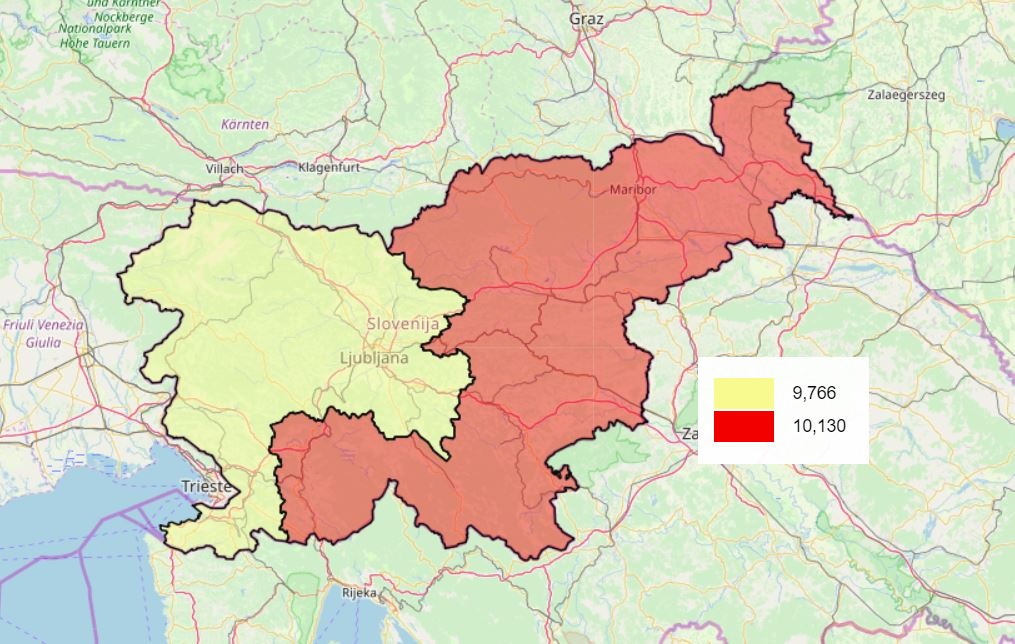Ljubljana related
Ever wondered where all the second homes are in Slovenia, the vikendi and those defined by the Statistical Office of the Republic of Slovenia (Statistični urad Republike Slovenije – SURS) as “dwellings reserved for seasonal and secondary use”? If so, wonder no more as we zoom in the data for 2018, the most recent year for which it’s available.
According to SURS, in 2018 there were a total of 19,896 such dwellings in Slovenia. Of these, 9,766 (49%) were in the west, and 10,130 (51%) in the east.
But that scale, the two “cohesion regions”, hides a lot of detail, and if we look at the 12 statistical regions then something become clear: that Gorenjska (AKA Upper Carniola) seems to be the most desired location, with 3,376 holiday homes, or just under 17% of the total, as seen in the following map and table.
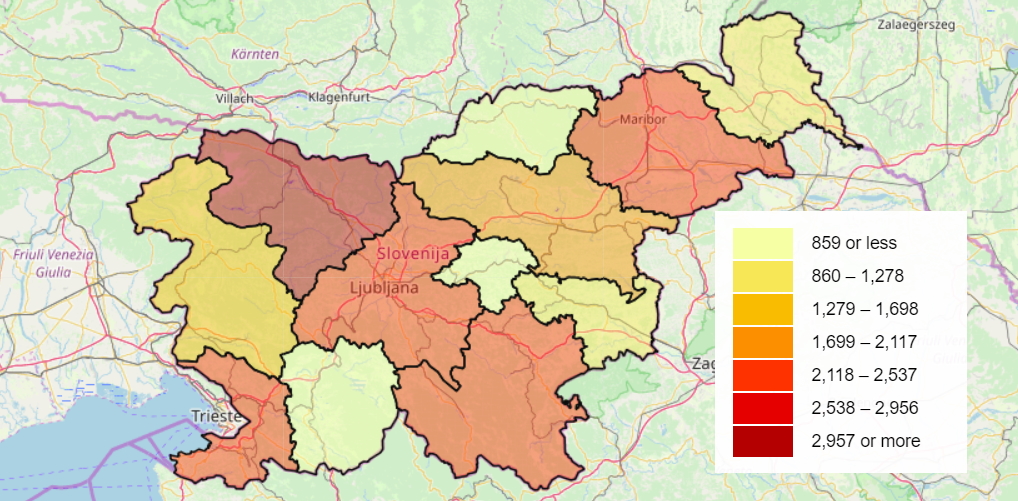
| Slovene | English | # | % |
| Gorenjska | Upper Carniola | 3,376 | 5.22 |
| Osrednjeslovenska | Central Slovenia | 2,489 | 12.51 |
| Obalno-Kraška | Coastal–Karst | 2,333 | 11.73 |
| Jugovzhodna Slovenija | Southeast Slovenia | 2,324 | 11.68 |
| Podravska | Drava | 2,168 | 10.90 |
| Savinjska | Savinja | 2,078 | 10.44 |
| Goriška | Gorizia | 1,568 | 7.88 |
| Posavska | Lower Sava | 1,037 | 5.21 |
| Pomurksa | Mura | 988 | 4.97 |
| Koroška | Carinthia | 650 | 3.27 |
| Zasavska | Central Sava | 446 | 2.24 |
| Primorsko-Notranjska | Littoral–Inner Carniola | 439 | 2.21 |
And the most popular place to buy a holiday home in Slovenia is...
Now zooming in to the highest level of detail that SURS offers – the 212 municipalities – we can see that there are seven areas where there are more than 500 holiday homes: Piran (1,038), Kranjska gora (961), Bohinj (843), Bovec (608), Brežice (526), Ljubljana (523), and Izola (512). You can visit an internactive version of the map below here and learn more, if wanted, while if you’re interested in more statistics about Slovenia then all our related stories are here.
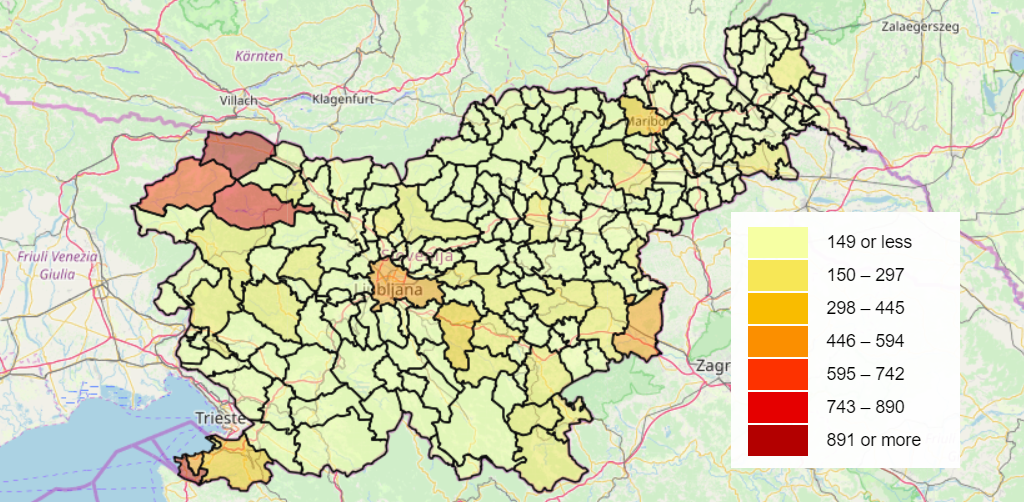
If you’re curious about some of the homes on the market, then check our real estate section, while all our stories on property are here.
STA, 20 December 2019 - Home price growth accelerated in the third quarter of 2019, with average prices rising by 8.5% year-on-year and 3.1% over the previous quarter on the back of strong growth in prices of used flats, show Statistics Office figures released on Friday.
Prices of second-hand homes rose by 3.1% over the previous quarter and 5.3% on the year before, mostly due to a 6% increase in the prices of houses.
While the prices of used apartments, the biggest single category of real estate, grew at a slower rate, 1.6% at the quarterly level, in Ljubljana they rose by 2.3%.
"Compared to average 2015 prices, used apartments in Ljubljana are now a full 39.7% more expensive," the statisticians said.
New homes were on average 2% more expensive than in the second quarter, but the figure masks a 3.3% quarterly decline in prices of apartments, which was offset by a 12.7% surge in the prices of houses.
Transactions remained brisk as well, as homes worth EUR 320 million changed hands in the three months, just EUR 10 million less than in the second quarter.
There were very few sales of new homes: second-hand homes accounted for EUR 310 million of the total transactions.
More on this data can be found here
The Slovenian Financial Administration (Finančna uprava) has issued a reminder that if you have property advertised on Airbnb, Booking and other non-Slovene providers then any income earned is subject to VAT. As such you much register as soon as possible, and submit your monthly VAT returns retrospectively (if needed) as a self-declaration in order to avoid fines.
If you rent out rooms, apartments or houses through intermediaries or advertising providers on websites (Airbnb, Booking, and the like) that are based outside Slovenia, you must pay 22% VAT as a recipient of brokerage services or advertising space. In order to benefit from such services you must first identify yourself for VAT purposes (even if you are not identified for VAT purposes because your turnover is below the mandatory VAT identification limit of €50,000).
You must submit monthly VAT returns electronically (via eDavki) and are not entitled to deduct VAT. You can correct any errors from previous periods by including them in your first (or current) VAT return. You also have to submit a VAT invoice even if you do not receive any income from the property in a given month (in which case you submit an empty invoice).
You must issue an invoice to the guest to whom you provided the service (i.e., renting out property for tourist leasing) and confirm it in the case of cash transactions. This is the case even if the guest paid for the service with a card or paid the advertising provider (Airbnb, etc) from whom you indirectly received this payment.
Taxpayers who "forget" to submit a monthly VAT return will receive a personal electronic warning in their personal inbox on eDavki. Failure to respond will result in a fine of €2,000. The Financial Administration notes with some regret that many people are not paying attention to the messages they receive on eDavki, and thus is asking all taxpayers to provide an e-mail address to ensure they receive such communication. This e-mail address must be sent to the Administration via the eDavki portal using the eSign-POS form.
Please note that this issue is of extra urgency given that the Administration is set to tighten controls in early 2020.
More information, in Slovene, can be found in a document entitled Oddajanje nepremičnin v turistični najem in DDV (Leasing of real estate for tourism and VAT).
STA, 12 December 2019 - The Finance Ministry has drawn up a blueprint for a law introducing government guarantees for housing loans. These would be fully guaranteed up to EUR 150,000 in principal provided the borrower provides 20% in the form of own funds.
Unveiling the proposal in Ljubljana on Thursday, Finance Ministry State Secretary Alojz Stana said the scheme was aimed at the young up to the age of 35, young families and those in fixed-term or precarious forms of employment not older than 40.
A 100% guarantee would be available for housing loans amounting to up to EUR 150,000 in principal with a maturity of up to 30 years, rescheduling included.
The borrower would have to chip in at least 20% in the form of own funds, which is in line with loan requirements of the central bank, Banka Slovenije.
The total amount of guarantees is planned at up to EUR 500 million in principal. The annual amount of funds would be determined in the state budget implementation acts.
The borrower would be able to pick the bank they take the loan from, while the guarantor would be able to pay up to six past due instalments to the bank instead of the borrower.
This option would be available to the borrower several times while the loan was active, but only under condition that liabilities from the recourse claim were settled.
If the guarantee was enforced, the state's recourse claim would be repaid from the proceeds from the sale of the property with the national Housing Fund having the pre-emptive right to buy.
Unofficial information indicates that the ministry is still looking for a solution how to enable the borrower who was unable to repay the loan to stay in the property.
One option would be non-profit rental, but there would be a scope for abuse.
The ministry says that the scheme is aimed at creditworthy borrowers, so it does not interfere with the central bank's tightening of criteria for consumer loans.
However, the ministry hopes that Banka Slovenije may reconsider the consumer lending brake because of the state guarantee scheme.
The ministry expects that the lending terms for state-guaranteed loans would be easier on the borrowers. It hopes that the scheme's impact on property prices would not be excessive.
The scheme would be implemented by the state-run export and development bank SID. Guarantees would be issued for loans hired until the end of 2030.
The blueprint has been agreed with the Ministry of the Environment and Spatial Planning and is expected to be submitted for public consultation in January.
The scheme would be just one of housing policy measures with the main objective being increasing the fund of rental housing. Housing policy measures are to be updated in a new housing loan that is in the pipeline.
Following the central bank restrictions on consumer lending, a state loan guarantee scheme has been proposed by the opposition Democrats (SDS), but the corresponding bill was voted down in parliament.
STA, 24 October 2019 - After three years of steep growth, real estate prices started to show signs of stagnation in the first half of 2019. Prices of flats are very close to the record figures seen in 2008, while prices of houses are lagging behind significantly, show data from the Mapping and Surveying Authority.
The average price for a second-hand flat in Slovenia in the first half of 2019 was EUR 1,810 per square metre, which was 1.7% more than in the second half of 2018.
Prices of flats have been growing fast since 2015, when a downward trend finally reverted after the 2008 economic and financial crisis.
Alone in the first half of 2018 the average price for a second-hand apartment increased by nearly 7%, the Mapping and Surveying Authority noted on Thursday.
But the second half of 2018 and the first half of 2019 saw the growth in prices slowing down to 2%, above all due to stagnation of prices in Ljubljana.
The average price for a second-hand apartment in Ljubljana was at EUR 2,780 per square metre between January and June, which was about 0.5% more than in the second half of 2018. The authority says that prices have stagnated in Ljubljana since the beginning of 2018.
Property prices still rising faster on the coast
A different trend was recorded on the coast, where prices of used flats are growing increasingly fast.
Average price for a second-hand flat on the coast, excluding the town of Koper, was at EUR 2,640, over 7% more than in the second half of 2018. This was also the highest growth rate recorded on the coast since 2015.
Data for Koper show that average price of second-hand apartments was at EUR 2,440, 4% more than in the second half of 2018. Prices of second-hand flats around Ljubljana were at EUR 2,180 (up 5%) and in Kranj they were at EUR 2.060 (up 7%).
Prices of houses have also been growing since 2015, albeit slower than prices of flats. Just like in flats, the biggest increase in prices was recorded in the first half of 2018 and growth of prices started slowing down at the beginning of 2019.
In the first half of the year, the average house sold in Slovenia was 169 square metres big, located on an average plot of 910 square metres, with an average price of EUR 127,000.
This compares to an average price of EUR 128,000 for an average house of 162 square metres located on an average plot of 980 square metres sold in the first half of 2018 and to an average of EUR 120,000 for an average house of 163 square metre on a 890 square metre plot sold in the second half of 2018.
In the first half of the year, prices of houses were highest in Ljubljana, costing EUR 286,000 on average, on the coast (excluding Koper) the average price for a house was EUR 264,000, while houses around Ljubljana cost EUR 193,000 on average.
Construction plots cost EUR 56 on average per square metre, which was about 10% less than in the second half of 2018 and some 3% less than in the first half of 2018.
The number of transactions in the first half of the year reached 17,100, which was 2% more than in the second half of 2018. Deals totalled to EUR 1.33 billion, up 11% over the second half of 2018.
Housing property accounted for 54% of all transactions. Transactions with flats amounted to EUR 432 million or 32% of total transactions, while sales of houses amounted to a total of EUR 290 million or 22% of the total transaction value.
STA, 19 October 2019 - Notary fees in Slovenia went up slightly on Saturday after more than a decade. Some of the notary fees have not been adjusted to inflation since 2002 and have also gone down several times, according to the Notary Chamber.
The adjustments took effect on Saturday and were set in cooperation with the Notary Chamber after intensive talks, the Justice Ministry has told the STA.
Notary Chamber head Sonja Kralj told the STA that the changes do not concern only the notary fees but also allow revaluation of services and introduce new definitions of individual notary services stemming from the class action act and family law.
In Slovenia, people most often turn to notaries for drafting of contracts and verification of signatures, according to Kralj.
Signature verification fees depend on the value of the contract. For example, the fee for verification of signatures on a contract worth up to EUR 4,590 will increase by a euro to EUR 6.
The drafting of a contract worth between EUR 114,750 and EUR 367,200 has so far cost EUR 275 and will from now on cost EUR 314.
Below is an overview of adjustments of some of the other notary fees in EUR.
Service old fee new fee ------------------------------------------------------------------ Verification of document copies (per page) 1.5 2 Written legal opinion (per page) 23 26 Access to the the property register, cadastre or the company register 23 26 Signature verification based on contract value value of contract subject old fee new fee ------------------------------------------------------------------ up to EUR 4,590 5 6 EUR 4,590-20,655 14 16 EUR 20,655-68,850 23 26 EUR 68,850-150,000 46 52 Source: Notary Fee
In contracts exceeding EUR 150,000, fees increase by EUR 11 (EUR 10 before) for every EUR 50,000 in contract value. However, in total, the fee cannot increase by more than EUR 114 (EUR 100 before).
STA, 23 September 2019 - Sales of new housing properties have dropped to the lowest level on record in the second quarter of 2019, according to data released by the Statistics Office. Meanwhile, more than 1,360 second-hand houses were sold this second quarter, the most since the second quarter of 2017. In total, sales reached highest value since 2017.
New flats are on the other side of the spectrum, as only 42 were sold, the least since new real estate sales have been recorded. But faring even worse were new houses, with only 18 of them being sold in the second quarter.
The prices of new housing properties dropped by 3.1% over the first quarter. Prices of new houses went down by 9.3%, while apartments grew by 0.3% after growing by 9% in the first quarter.
On the yearly level, prices of new real estate increased by 3.6%: flats went up by 9.3%, while houses were 6.3% cheaper.
Prices of second hand real estate went up by 1.5% over the previous quarter; houses by 2.5% and apartments by 1%. Compared to the same period last year, prices of second-hand properties were up 2.1%; apartments increased by 2.3% and houses by 1.7%.
In total, EUR 330 million deals were closed, the most since the second quarter of 2017, when the figure reached EUR 354 million.
Prices have gone up by 1.3% in the second quarter compared to the first and have grown by 2.2% compared to the same period last year.
We’ll be honest, our eyes landed on this property because we know where it is, in a building that we’ve long wondered what the apartments were like inside. Are they all as clean and bright as this one? I don’t know, but as the following pictures show, there are some very nice homes in centre of Ljubljana.
The pin marks the street, not the exact location of the apartment
This one appears to be in a courtyard on Vegova, the one that starts in Kongresni trg with the beautiful university building, goes on to the music school, continues with the National Library, and ends in French Revolution Square, with the heart of the Ljubljana Festival, Križanke. It’s a very nice area.
The apartment is available for rent, with the price being €1,050 a month based on a contract of at least 6 months, utilities not included. It’s being handled by Think Slovenia, with offices not far away, who described the property as follows:
Spacious renovated apartment in a fantastic quiet, central Old Town location on Vegova street next to the National Library and a few steps from Križanke and Congress square. The apartment lies on the first floor of a charming, historic, old town building with internal courtyard and parking area.
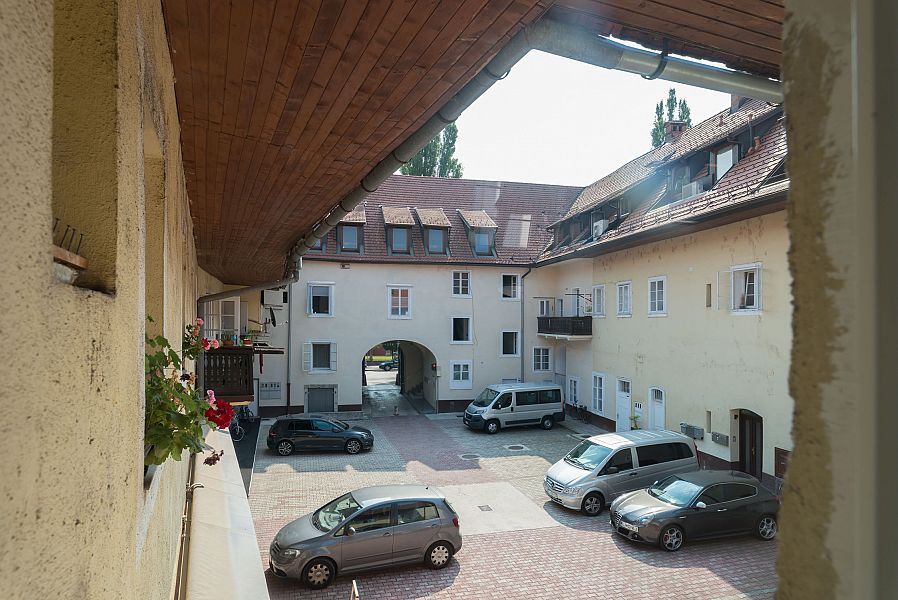
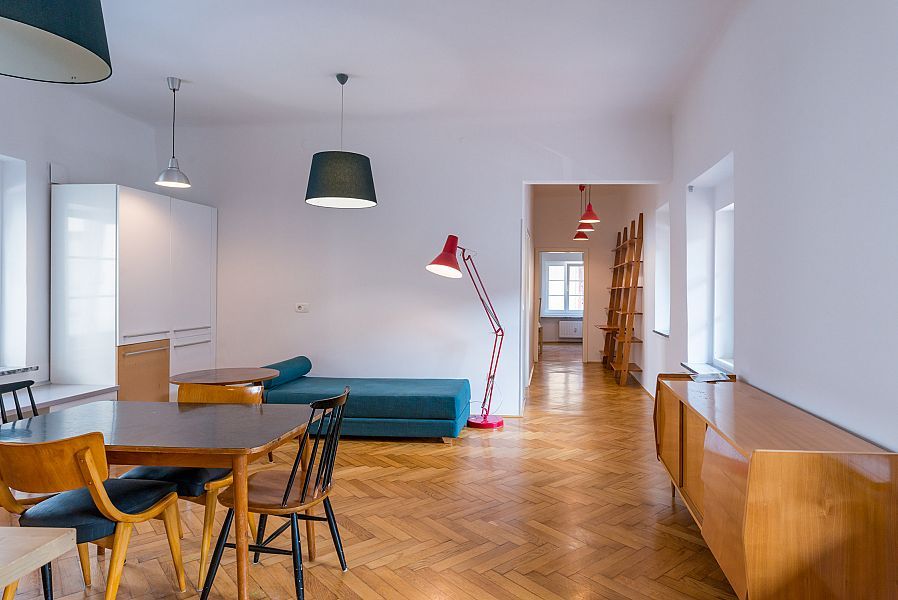
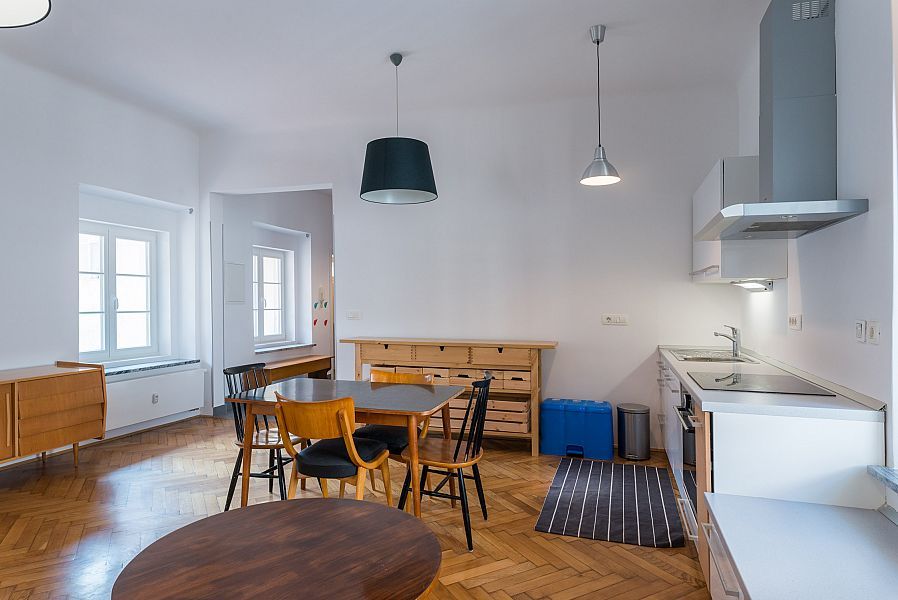

The apartment comprises an entry room, spacious bathroom, separate toilet, bright open plan kitchen with living area with windows and two large bedrooms. The bathroom and toilet have underfloor heating, the rest of the apartment has radiators. There is a small storage room in the basement belonging to the apartment.
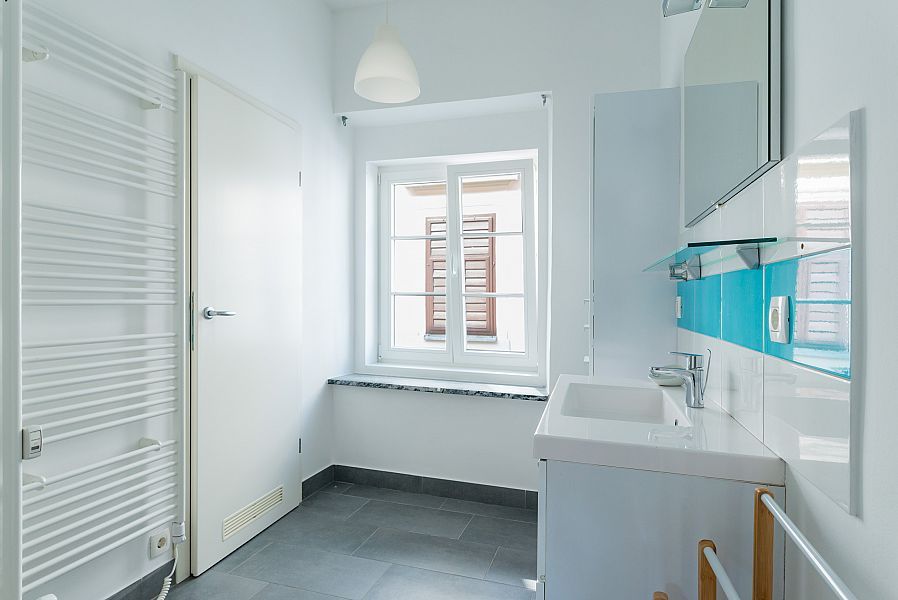
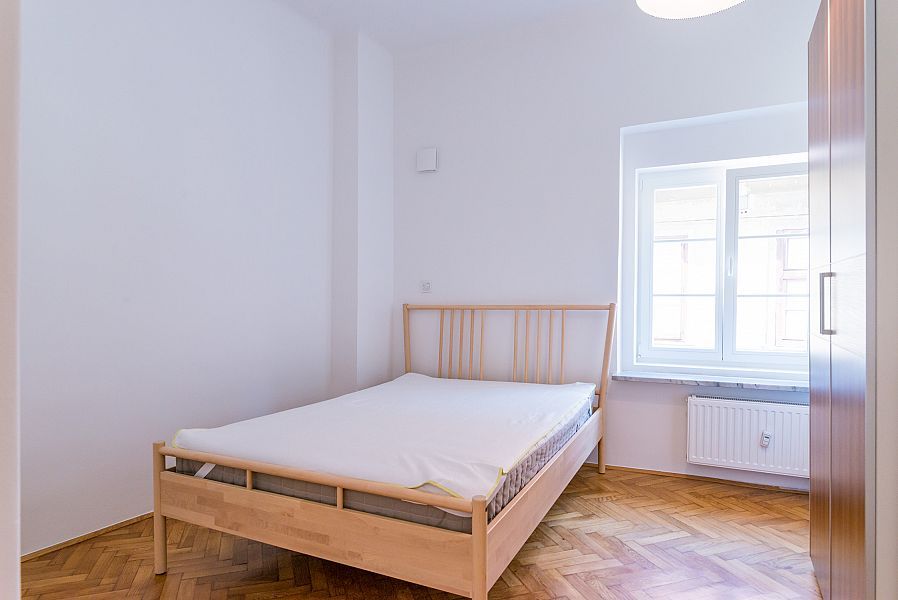

The location on Vegova street on one hand offers easy access to numerous excellent restaurants, bars and all the attractions of the Old Town, whilst on the other it offers very easy access to the Ljubljana south ring road. The apartment is rented out furnished and has been recently renovated to a high standard.
You can see more of this, and other properties for sale or rent all over the country, at Think Slovenia
STA, 29 August 2019 - While the volume of construction work in Slovenia in the first half of the year was up by 14% year-on-year, certain statistical indicators suggest the trend may reverse. Major builders expect the volume of business to be similar to last year's, but are cautious as they would like to see more stability in state investments.
The volume of construction work has increased, but the statistics on building permits suggests that the trend could reverse in the near future, as the number of permits has been dropping steadily over the past three years.
In the first half of 2019, the number of approved permits was down by 10% year-on-year, with the number of permits for residential buildings increasing, and the number of permits for non-residential buildings significantly dropping.
The latest business sentiment data for the sector show a deterioration both on the monthly and annual levels, but the indicator is still above the long-term average. Construction companies have decreased their prospects of hiring, while expectations related to orders are somewhat more optimistic.
Major builders such as Kolektor Koling, Kolektor CPG, CGP and Pomgrad have confirmed for the STA that they are cautious regarding future operations. They expect this year to be similar to last, and are ready for a potential cooling of the market.
They would like to see more stability on the market, including by the state embarking on major projects, especially in road infrastructure.
Kolektor Koling and Kolektor CPG say that there is demand for construction work and that this will be the case at least until the end of the year. They complain about the growth of costs and prices of input material and a shortage of qualified staff.
The members of the construction arm of the Kolektor conglomerate are currently building a new technological centre of the national grid operator ELES, upgrading the Rimske Toplice-Laško railway and reconstructing the railway infrastructure in the Croatian port of Rijeka.
For 2020, they expect the current rate of growth to be maintained, but are cautious about many risk factors, so they will constantly monitor the situation and be ready for a quick response to possible changes.
Kolektor Koling and Kolektor CPG admit that the construction sector in the country is highly dependent on public projects, such as the new Koper-Divača railway line, the Third Development Axis expressway and the second tube of the Karavanke tunnel.
"If the state stays true to its commitments and provides for a continuity of demand, then we can expect a stable and healthy growth also after 2020," they assessed.
The company CGP currently operates at full capacity, with its ongoing projects including a multi-storey car park in Koper, a high-end residential and hotel complex in Ljubljana and a Lidl logistics centre in Arja Vas, among others.
"We intend to end this year on a par with the previous year," said the company whose projects in the coming year include an Ikea shopping mall in Ljubljana and construction of apartments for the public Housing Fund.
"In the coming years we see a lack of projects mostly in the field of reconstruction and construction of public roads," CGP has told the STA, pointing a finger to the government.
Pomgrad is also operating at full capacity this year, with its ongoing projects including the upgrade of the Pesnica-Šentilj and Poljčane-Slovenska Bistrica rail sections and elderly homes near Ptuj and in Croatia's Osijek.
Together with GH Holding and VGP Drava Ptuj of Slovenia and the Croatian utility company Bikarac, they have signed a EUR 26.5 million deal to design and build a waste management centre for the city of Šibenik and its surroundings.
According to Pomgrad management board member Boris Sapač, the company expects to sign some more major contracts soon. But he complained about "public procurement procedures being too slow, which makes it hard to make plans".
The company has noticed a standstill in investment in state roads, which is something it does not welcome. "The volume of investment or tenders should be stable. This would also be good for road infrastructure, which is in a poor condition."
Sapač said that builders needed stable conditions instead of steep annual growth rates and deep falls. "This is why we are cautious optimists in our company. Excessive growths are not sustainable in our sector."
Statistical Office of the Republic of Slovenia, SURS, has released figures showing that construction firms performed €2,571 million of construction work in 2018, an increase of 29% on in 2017.
Of this, €1,351 million of construction work was done on buildings (up 35% on 2017) and €1,220 million on civil engineering projects (up 23%).
Most of this construction work was performed on non-residential buildings (€906 million, or 38% more than in 2017).
You can find more about this data at SURS, while all our stories on property in Slovenia are here, while all our statistics are here


